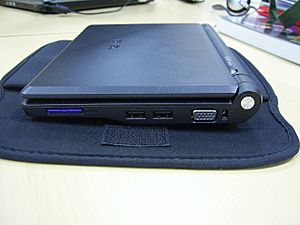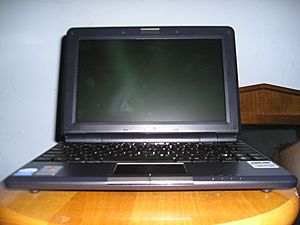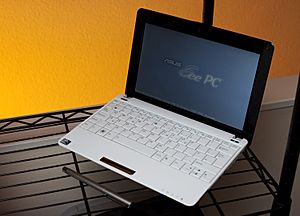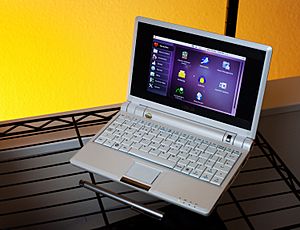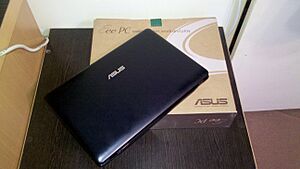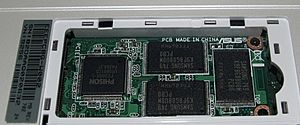Asus Eee PC facts for kids
 |
|
 |
|
| Developer | Asus |
|---|---|
| Type | Netbook |
| Operating system | Linux (Xandros) Windows (XP, 7, 8.1) |
| CPU | Intel (Celeron, Atom) AMD (AMD Fusion) |
The ASUS Eee PC was a special line of small, portable computers called netbooks. They were made by a company called Asus. When they first came out in 2007, people liked them because they were light, used a simple Linux operating system, had fast solid-state drives (SSDs), and didn't cost too much.
Later, newer Eee PC models also offered Microsoft Windows and regular hard disk drives (HDDs). The name "Eee" comes from "Easy to learn, Easy to work, Easy to play."
The first Eee PC was a big deal in the computer world. It helped create the idea of small, low-cost laptops. In January 2013, Asus stopped making the Eee PC because more people started buying tablets and Ultrabooks. However, they brought the idea back in 2015 with the EeeBook series.
Contents
History of the Eee PC
Early Eee PC Models (700 Series)
Asus showed off the first Eee PC models, the 701 and 1001, in 2007. The 701 model came out in October 2007. These small computers were much cheaper than other similar tiny PCs. The Eee PC was also a response to the XO-1 laptop, which was made for children in developing countries.
Some models were called EeePC 8G, 4G, 4G Surf, and 2G Surf. The "Surf" models often had less battery life or no webcam. In early 2008, Asus also released Eee PCs with Windows XP already installed.
Some of the very first 700-series models had a small problem: their battery would slowly drain even when the computer was turned off.
How users changed them
Some people who owned the 701 model changed it to put in a bigger solid state drive. The 8 GB versions of the 700 series had a special slot for the SSD, making it easier to replace.
Eee PC 900 Series
The Eee PC 900 series came out in April 2008. These models were a bit bigger than the 700 series, measuring about 22.5 cm wide and weighing around 1 kg. They had a special touchpad that let you scroll and zoom with two fingers. You could buy them with either Linux or Windows XP.
The Eee PC 900 used an Intel Atom processor. It came with different amounts of storage, like 8 GB or 16 GB SSDs. Some even had a mix of SSDs for a total of 20 GB. The Windows XP versions usually came with less storage than the Linux ones for the same price.
Other 900 Series Models
In June 2008, Asus introduced the Eee PC 901. This model had a different look and a faster Intel Atom processor (1.6 GHz). It also had a bigger battery that could last 4 to 7.8 hours. Plus, it included Bluetooth and faster 802.11n Wi-Fi.
The Eee PC 904HD was one of the first models to use a regular 80 GB hard disk drive instead of an SSD. It had an Intel Celeron M processor and a long-lasting battery. The 904HA was another model with a 1.6 GHz Intel Atom processor and a 160 GB hard drive.
The Eee PC 900A was similar to the 901 but used the older 900 model's case. In 2009, Asus also released the Disney Netpal, which was like the 900 series but designed for kids.
Eee PC 1000 Series
The 1000 series launched in June 2008. These models had a new 10-inch screen and a 1.6 GHz Intel Atom processor. The 1000 model came with Linux and a total of 40 GB of SSD storage. The 1000H model came with Windows XP or Linux and a larger 80 GB or 160 GB hard disk drive.
Both models could have up to 2 GB of RAM. They also had a keyboard that was 92% the size of a regular laptop keyboard, making it easier to type. Like the 901, they had fast Wi-Fi and Bluetooth.
The 1000HD (released in September 2008) was a cheaper version of the 1000H, using a slower 900 MHz Celeron processor. The 1000HA (October 2008) was also cheaper but kept the faster 1.6 GHz Intel Atom processor and a 160 GB hard drive.
In February 2009, Asus showed the 1000HE. It used a newer Intel Atom processor and had a great battery life of up to 9.5 hours. It also had a new keyboard style, similar to Apple's computers.
Even though the 1000 series screens were 1024x600 pixels, they could show a "virtual" 1024x768 desktop. This meant the screen could shift to show hidden parts of a webpage or document.
At a big tech show in 2009, Asus revealed the 1005HA, which had a new "Seashell" design. This model came in different versions, with varying battery sizes and cameras.
Later, Asus released the 1201N with special Nvidia Ion graphics, which made it better for videos. This was followed by the 1215N with a more powerful dual-core Atom processor. The 1215 series also included the 1215B, which was the first Eee PC to support "virtualization," allowing it to run different operating systems at the same time more easily.
Later Eee PC Models (1025c, 1025ce, 1015 Series)
The 1025c and 1025ce models came out in 2012. They were known for having very long battery life. However, they only had 1 GB of memory and regular USB2 ports, making them a bit slow. It was also hard to upgrade their memory.
In 2013, Asus brought back the Eee PC series with the 1015E models. Some of these came with Windows 8 and others with Ubuntu Linux. They had 2 GB of memory and faster USB3 ports. The 1015E was quicker than the 1025C, but its battery didn't last as long.
EeeBook Series
In 2014, Asus launched the EeeBook line of computers, starting with the X205TA. By 2017, the EeeBook models were replaced by the Asus VivoBook E Series. Some EeeBook laptops were even renamed to VivoBook E Series models.
How the Eee PC was built (Hardware)
Processor
Eee PC models usually used special processors designed for netbooks. The first Eee PCs had an Intel Celeron M processor. Later models used Intel Atom and AMD Fusion processors, which were good for small, low-power devices.
Screen (Display)
The Eee PC 700 had a 7-inch screen with 800x480 pixels. The screen didn't fill the whole lid; there were speakers on the sides. The Eee PC 900 and 901 had larger 8.9-inch screens with 1024x600 pixels, which almost filled the lid.
Newer models came with even bigger screens, from 10 inches to 12.1 inches, and higher resolutions. All Eee PC models could connect to an external monitor using a standard VGA port.
Keyboard
The keyboards on the 700 and 900 series Eee PCs were about 82% the size of a regular laptop keyboard. The 1000 series, being larger, had a keyboard that was 92% the size of a full keyboard, making it more comfortable to type on.
Some Eee PC models, like the 1000HE and 1215s, used an "island-style" keyboard. This means the keys were spaced apart, similar to keyboards on Apple and Sony VAIO computers.
Storage
Early Eee PC models used solid-state drives (SSDs) instead of traditional hard disk drives. SSDs use less power, start up faster, make no noise, and are tougher against bumps. However, they can only be written to a certain number of times.
In the 700 series, the SSD was sometimes soldered right onto the main board. In other models, like the 8 GB version, the SSD was a card that could be removed. The Eee PC 900 also came with a removable SSD module.
Some models, like the 1000H and 904HD, used regular hard disk drives (HDDs) instead of SSDs. All Eee PC models also had a memory card reader for extra storage, supporting SD and MMC cards.
Memory (RAM)
Most early Eee PCs used DDR2 SDRAM memory modules that could be swapped out for upgrades. However, some models had the RAM soldered directly onto the motherboard, making it harder to upgrade. Later models, like the 1025c and 1025ce, also had soldered RAM.
Cooling
The Eee PC used a clever way to cool down: the keyboard itself acted as a heat sink to absorb heat from the processor. There was also a fan and vents to help keep the system cool.
Operating Systems (Software)
Most Eee PC models came with either Windows XP or a special version of Linux called Xandros. Later models, like the 1015E, shipped with Windows 7 Starter or Ubuntu Linux.
Many users also tried installing other operating systems on their Eee PCs, and many worked well. Some popular choices included:
- Different versions of Linux, especially lighter ones like Lubuntu or Debian.
- ChromeOS and Android x86.
- Various versions of Mac OS X.
- Newer versions of Windows Vista, 7, 8, 8.1, and 10.
It's important to remember that some of these operating systems are now old or no longer supported for the Eee PC's older hardware.
Fanbase and continued use
The ASUS Eee PC netbooks still have a small group of fans. These people like them because they are affordable, lightweight, and tiny, making them great for travel. However, because they don't have powerful processors and aren't compatible with all modern software, they are not used as much today. Newer, cheaper options like Chromebooks have largely replaced them.
Images for kids
See Also
 In Spanish: ASUS Eee PC para niños
In Spanish: ASUS Eee PC para niños
- Asus EeeBox PC
- Unofficial Reddit-based fanpage: https://www.reddit.com/r/eeepcmasterrace/comments/7w4nu0/best_operating_system_for_eee_pc/
- Asus Eee Top
- CMOS battery
- Comparison of netbooks
- Comparison of netbook-oriented Linux distributions
- Internet appliance
- Rechargeable battery


